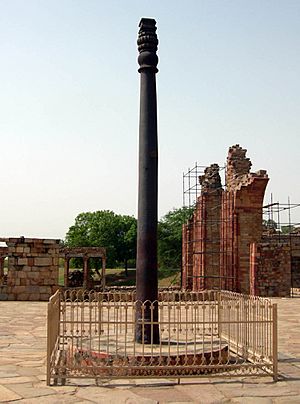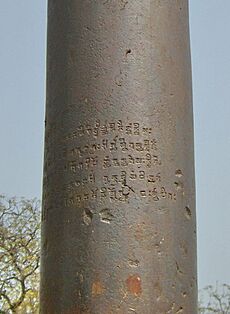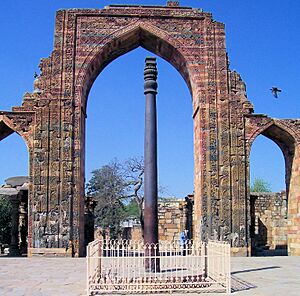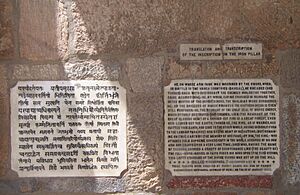Iron pillar of Delhi facts for kids
Quick facts for kids Ashoka pillar of Delhi |
|
|---|---|

Iron pillar of Delhi
|
|
| Location | Qutub Minar complex, Delhi, India |
| Built | 5th century CE |
| Architect | Chandragupta II |
| Architectural style(s) | Hindu architecture |
| Type | Cultural |
| Criteria | iv |
| Designated | 1993 (17th session) |
| Part of | Qutb Minar and its monuments |
| Region | India |
The Iron Pillar of Delhi is a very old and tall structure. It stands about 7.21 meters (23 feet 8 inches) high. This amazing pillar was built by Chandragupta II, a powerful king who ruled from about 375 to 415 CE. Today, you can find it in the Qutub complex in Mehrauli, Delhi, India.
What makes this pillar special is that it hardly ever rusts! The metals used to build it have a special mix that resists rust. The pillar is super heavy, weighing more than six tonnes (over 13,000 pounds). Experts believe it was first set up somewhere else, maybe near the Udayagiri Caves. Later, in the 11th century, Anangpal Tomar might have moved it to its current spot.
Contents
What Does the Iron Pillar Look Like?
The Iron Pillar is very tall. From top to bottom, including the part underground, it measures 7.21 meters (23.6 feet). About 1.12 meters (3.6 feet) of it is buried below the ground. The top part, which looks like a bell, is about 306 millimeters (12 inches) wide.
Scientists and historians are very interested in this pillar. It's famous for not rusting, even after so many centuries. This shows how skilled ancient Indian metalworkers were. They were able to extract and process iron in a very advanced way. The pillar's rust resistance comes from a special layer that forms on its surface. This layer is made of iron hydrogen phosphate hydrate, which protects the iron from Delhi's weather.
What Are the Inscriptions on the Pillar?
The Iron Pillar has several writings carved into it. These carvings are called inscriptions. They were made at different times throughout history. Even though the pillar is famous and easy to see, some of these inscriptions haven't been fully studied yet.
The Inscription of King Chandra

The oldest and most important inscription on the pillar is about a king named Chandra. Most experts believe this King Chandra was actually Chandragupta II, a famous emperor from the Gupta Empire.
How Was the Inscription Made?
This inscription covers an area of about 65 centimeters by 26.67 centimeters (2 feet 9.5 inches by 10.5 inches). The ancient writing is still very clear. This is because the iron itself resists rust, which helped preserve the carvings. However, when the letters were carved, the iron sometimes closed up a bit. This made some of the letters look a little imperfect.
The inscription is written in Sanskrit, an ancient Indian language. It uses a poetic style called shardulvikridita metre. The writing style is similar to other writings from the Gupta period. The letters are small, ranging from 0.3125 to 0.5 inches in size. They look a lot like the letters found on the Allahabad Pillar inscription.
Who Studied the Inscription?
Many people have studied the Iron Pillar's inscription over the years.
- In 1831, William Elliott, an officer from the East India Company, made a copy of the inscription.
- Based on this copy, James Prinsep published a drawing in 1834. He later made an improved drawing and translation in 1838.
- Later, Bhagwan Lal Indraji made another copy. Using this, Bhau Daji Lad published a new translation in 1875. He was the first to correctly identify the king's name as Chandra.
- In 1888, John Faithfull Fleet published a very detailed version of the text.
- More recently, in 2005, R. Balasubramaniam noticed that the letters on the Delhi inscription looked very similar to dated inscriptions of Chandragupta II found at Udayagiri Caves.
Who Wrote the Inscription?

The inscription doesn't have a date, and it doesn't say which dynasty King Chandra belonged to. This led to a lot of discussion about who this king was and when the pillar was made. However, most experts now agree that King Chandra was the Gupta King Chandragupta II.
Here's why they think so:
- The writing style and poetry match the Gupta period (late fourth or early fifth century CE).
- The inscription says the king was a follower of the god Vishnu. It also mentions setting up a pillar for Vishnu on a hill called Viṣṇupada. Other Gupta inscriptions also say Chandragupta II was a devotee of Vishnu.
- The short name 'Candra' is found on gold coins of Chandragupta II.
- A royal seal of Chandragupta's wife, Dhruvadevi, also mentions "Nārāyaṇa, the lord of the illustrious Viṣṇupada."
Some scholars wondered if the inscription was written after King Chandra had died. However, others believe it was written while he was still alive. They think it might have been made when Chandragupta II decided to leave his throne and live a retired life in Viṣṇupada.
What Does the Inscription Say?
The inscription is a praise for King Chandra. Here is a translation from J. F. Fleet (1888):
(Verse 1) This king, whose arm was famed for his sword, defeated enemies in the Vanga countries (Bengal). He also conquered the Vahlikas after crossing the seven mouths of the Sindhu river. Even now, the southern ocean is filled with the scent of his bravery.
(Verse 2) The great power of his energy completely destroyed his enemies. Like the heat from a burned-out fire in a big forest, the remains of his power still stay on Earth. Even though he, the king, as if tired, has left this Earth and gone to the other world, he remains on Earth through the memory of his fame.
(Verse 3) This king, named Chandra, gained supreme rule over the world by his own strength. He enjoyed this rule for a very long time. His face was as beautiful as the full moon. With faith, he dedicated his mind to the god Vishnu. Because of this, this tall pillar of the divine Vishnu was set up on the hill called Vishnupada.
The Samvat 1109 Inscription
There's another short inscription on the pillar. It's linked to the Tomara king Anangpal. It's a bit hard to read, but Alexander Cunningham (in 1862–63) read it as:
Samvat Dihali 1109 Ang Pāl bahi
[Translation:] In Samvat 1109 [1052 CE], Ang [Anang] Pāl peopled Dilli
Based on this, Cunningham thought Anangpal moved the pillar when he founded the city of Delhi. However, other scholars have read it differently. Buddha Rashmi Mani (1997) read it as:
Samvat Kinllī 1109 Aṅgapāla bādi
[Translation:] Anangpal tightened the nail [iron pillar] in Samvat 1109
Where Was the Pillar Originally Located?
The Iron Pillar was placed in the Quwwat-ul-Islam mosque and the Qutb complex by Sultan Iltutmish in the 13th century. But where was it before that? That's a big question for historians.
The inscription of King Chandra mentions that the pillar was set up at Vishnupadagiri (meaning "hill with footprint of Vishnu"). Some early scholars thought this place might be Mathura. However, Mathura is mostly flat, and there isn't a true "giri" (hill) there.
More recent research suggests the pillar was originally at the Udayagiri Caves. This idea is supported by:
- The similarity of the writing style to other inscriptions found at Udayagiri.
- The religious symbols from the Gupta period found there.
- Studies of the metal used in the pillar.
Udayagiri was an important place for King Chandragupta II and for the worship of Vishnu during the Gupta period. Also, the area around Udayagiri was known for mining and working with iron. This makes it a likely original home for the pillar.
How Did the Pillar Get to Delhi?
It's not completely clear when the Iron Pillar was moved to Delhi.
- One idea is that the Tomara king Anangpal moved it. This is based on the short inscription linked to him. An old Jain text from 1132 CE mentions a pillar that caused the "Lord of the Snakes to tremble." If this refers to the Iron Pillar, it means it was already in Delhi during Anangpal's time.
- Another idea is that it was moved during Muslim rule in Delhi. Some think it happened around 1200 CE, when Qutb al-Din Aibak started building the Qutb complex.
- Historian Finbarr Barry Flood (2009) believes Iltutmish (who ruled from 1210–1236 CE) moved the pillar. He suggests the pillar was originally in Vidisha. When Iltutmish attacked and took over Vidisha in the 13th century, he might have taken the pillar as a trophy and moved it to the Qutb Minar complex. This is similar to how the Tughluq rulers later brought Ashokan pillars to Delhi.
Was the Pillar Hit by a Cannonball?
If you look closely at the middle of the pillar, about 4 meters (13 feet) from the ground, you'll see a big dent. Experts believe this dent was caused by a cannonball fired at close range. The impact also created cracks on the opposite side of the pillar, but the pillar itself stayed in one piece.
There are no old records that describe this event. However, historians generally agree that Nadir Shah probably ordered the pillar to be hit during his invasion of Delhi in 1739. He might have wanted to destroy a Hindu monument within an Islamic mosque complex. Or, he might have been trying to knock off the top part of the pillar, hoping to find hidden jewels or other valuable items.
No other cannonball damage has been found on the pillar. This suggests that no more shots were fired. Historians think that pieces of the cannonball might have bounced off and damaged the nearby Quwwat-ul-Islam mosque. The mosque's southwestern part was damaged around the same time. This might have caused the attack on the pillar to be stopped.
See also
- Related topics
- Ancient iron production
- History of metallurgy in South Asia
- Parkerizing
- Serpent Column
- Wootz steel
- Other pillars of India
- Ashoka's Major Rock Edicts
- Dhar iron pillar
- List of Edicts of Ashoka
- Pillars of Ashoka
- Heliodorus pillar
- Stambha
- Other similar topics
- Early Indian epigraphy
- Hindu temple architecture
- History of India
- Indian copper plate inscriptions
- Indian rock-cut architecture
- List of rock-cut temples in India
- Outline of ancient India
- South Indian Inscriptions
- Tagundaing




